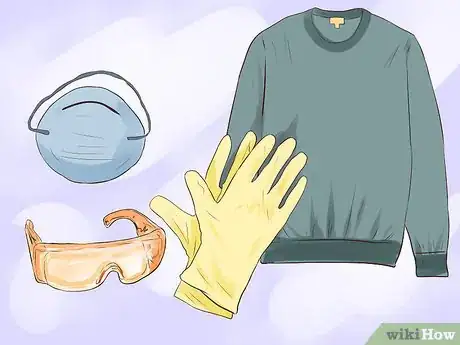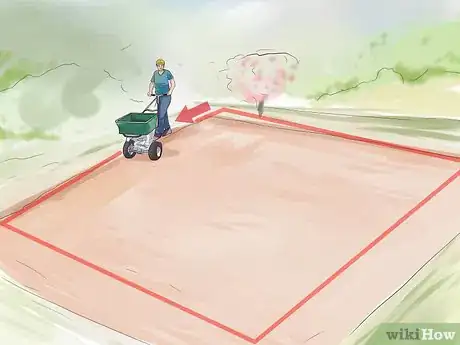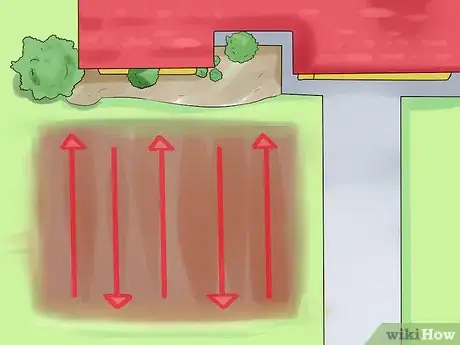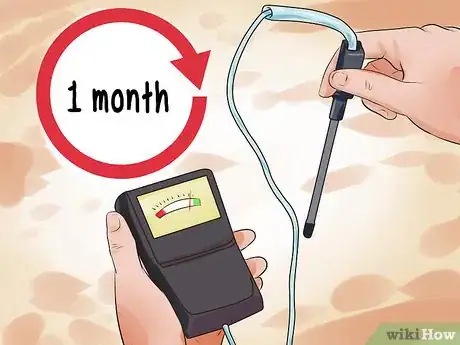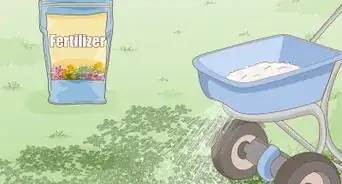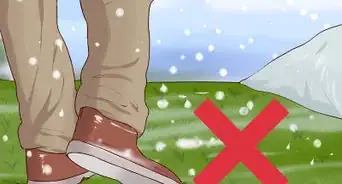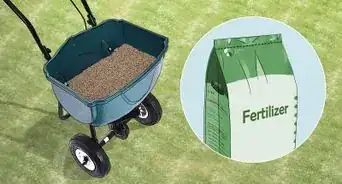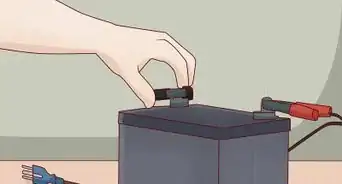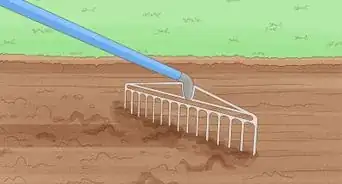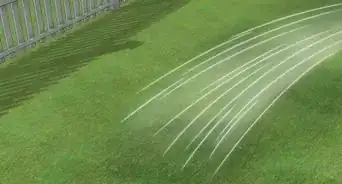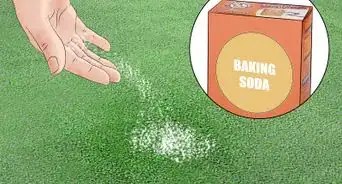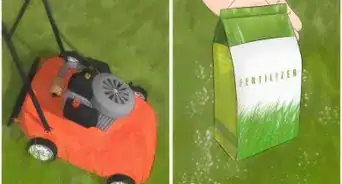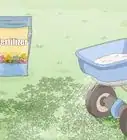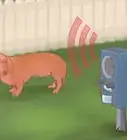This article was co-authored by Maggie Moran. Maggie Moran is a Professional Gardener in Pennsylvania.
There are 8 references cited in this article, which can be found at the bottom of the page.
wikiHow marks an article as reader-approved once it receives enough positive feedback. In this case, 85% of readers who voted found the article helpful, earning it our reader-approved status.
This article has been viewed 368,854 times.
Lime is derived from limestone and is used in agriculture and gardening to balance the acidity level of soil. For home use, it is typically bought in pellets or powder. Lime is spread on lawns that are not growing well to help the soil become more hospitable for grass. Spreading lime is best done after you test the soil to find out the pH level, which measures acidity. The process involves purchasing the right amount of lime, using a spreader, tilling the ground, watering to help the lime take, and checking again after one month and one year to see how the lime has affected the soil’s pH.
Steps
Testing Your Soil
-
1Buy a pH probe or test kit. To check for soil pH, and other soil properties, you need to use either a liquid test kit, which is comprised of tubes, an eyedropper, and testing solution, or a probe which you stick down into the soil. Probes and liquid tests kits seem to give about the same quality of reading, but probes can give out where liquid tests won’t. You can buy a basic probe or test kit fairly cheaply (around $10) at home improvement or garden stores.[1]
-
2Test your soil’s pH. Before you purchase lime and start spreading it, you always want to make sure your soil needs it. This test will tell you what the pH of your soil is and whether or not it needs lime. A pH of between 6 and 7 is typically where your lawn will grow best. Lime corrects soil acidity by raising the pH, so if your soil tests below 6, it probably means you need to spread lime.[2]
- Follow the specific testing guidelines on the product that you purchase.
Advertisement -
3Get the soil professionally tested. The basic home test will give you an idea if your soil is too acidic and needs lime, but it will not tell you exactly how much lime you need to raise the pH to the best spot. So it is also recommended to get a professional test done to find out how much lime your soil needs to correct the problem.[3]
- Finding a soil testing lab near you may be a little difficult, but many labs allow you to send your sample in through the mail and they will send a report back. Both the University of Tennessee Extension and the University of Massachusetts take samples by mail, so a good option may be to contact a university near you and find out if they do soil testing. This process can take a week or so to complete.
Gathering the Supplies
-
1Purchase the lime you need. Once you have the professional test results on how acidic your soil is, this will guide you on how much lime to buy. As a general rule, regardless of soil acidity, 50 pounds of lime should cover about 1000 square feet (23 kg, 93 square meters) of land. Consider the size of the area you need to cover and buy with this rule in mind.[4]
- Lime comes mainly in pellets or powder, and is categorized as calcitic or dolomitic. Dolomitic is typically best for lawn care because it is rich both in Calcium and Magnesium, prime nutrients for a healthy yard.
-
2Purchase a spreader. If you already have a spreader, great. However, if this is your first time treating your yard, you will need to buy one. A spreader is a wheeled basin that distributes the lime as you push the spreader forward. There are two basic kinds: drop spreaders and rotary (broadcast) spreaders. Drop spreaders drop the mineral/chemical straight down through holes in the bottom of the basin and rotary spreaders use a mechanism to flip it in a broader circle. Drop spreaders tend to be more precise while rotary spreaders tend to be faster and cover more area.[5]
- The choice of which kind is essentially up to you, but you may ask a few people you know, or an employee at the store, to see if they have a suggestion. If you have a large yard, the rotary spreader is probably the better choice since it covers more area. If you have a small yard and want a more precise spread, the drop spreader is probably best for you.
-
3Use safety gear. It is recommended to use gloves anytime you handle lime because it can burn the skin a little. It is not mandatory to wear safety goggles, but it is also a good precaution to take just in case. If you are spreading the lime on a day that is windy at all, a basic breathing mask is also recommended. While lime has not been found to be toxic to people or animals, it can irritate the skin so best to keep your skin, eyes, and mouth covered. Never spread lime by hand, even with gloves on. It is less effective than a spreader, anyway, but is also not a safe practice.[6]
- Keep your kids away from the yard when you are spreading the lime, and off of the yard for a couple days while the lime sets. While lime has not been found to cause illness or death, it can often irritate the skin, so best to be cautious.
- Lime has also not been found to be toxic to animals, but it is best to keep pets off of the yard for a couple days, as well.
Treating Your Yard
-
1Till your yard. This is not a mandatory step, as you may not have the time or option for this, but it is recommended. By tilling your yard before spreading the lime, you make it easier for the lime to really get down into the soil. While it is perfectly fine to simply lay the lime out on the surface of the yard, it will have more contact with the soil if you till the ground first.[7]
- This is best achieved by a motor-powered rototiller, but you could also use a hand tiller or shovel to turn over the soil throughout the yard.
-
2Get the spreader ready. Set the spreader on concrete when you fill it, and pour the lime into the basin of the spreader. Check if there is a specific fill line, and if not, leave about an inch from the top empty. Read the instructions on both the lime and the spreader, and set the spread rate appropriately. If there is a half-rate setting, use this because you will be making two passes at the yard.
-
3Walk an outline of the yard. The shape of your yard will determine the exact pattern you lay the lime in, but the main idea is to make sure you cover the entire yard. A good place to start is to walk the entire perimeter of the area you want to cover. This outline strip will give you a buffer for making turns at the end of a strip.[8]
-
4Make passes back and forth. For the first pass of the yard, walk straight lines back and forth from one end of the yard to the other end. To maintain straight lines, try to keep the wheels of the spreader in the wheel marks you made on each previous pass. If your yard is irregularly shaped, you may struggle to keep the lines “straight,” but do your best to keep each line following the pattern of the line you made just before it. Always start pushing the spreader before you squeeze the lever that opens the bottom.
- If you start to run low on lime in the basin, don’t shake it. Simply leave the spreader where you are and go get more lime to refill it.
- Be sure to use the half-rate setting, since you will make double coverage of the yard. If there is not specifically a half rate, it’s best to go with something lower than half.
-
5Apply the second round criss-crossing the first. Now you will walk lines that run perpendicular to the first set of lines you made, crossing that set. This technique will help give you even coverage across the whole yard, covering any bare spots you might have left the first time.[9]
- You don’t want to overdo it with lime, so only make two passes over the lawn.
- If you have followed the instructions on the lime and on the spreader, you should have the right amount. People tend to say that there isn’t a good way to correct if you put too much in one spot, so you just have to let the lime set over time and it will balance out.
-
6Water your yard. Lime is a slow acting mineral, so it will take months to work its way into your soil no matter what. But to speed the process initially, lightly watering the whole yard is a good way to help the lime start soaking down into the soil. Any particles that are stuck to the blades of grass will be washed down into the soil. You don’t want to flood the yard by any means. Just give it enough of a watering to dampen the top of the soil.
-
7Check the pH one month later. Raising the pH of your lawn is not an exact and immediate process. You may need to apply lime more than once if your soil is very acidic and the pH needs to be raised more. After one month, run another pH test to see whether or not the soil could use more lime.
- Keep in mind that it does take about six months for the soil to really change pH, so your second test may not show up too differently. Balancing your yard’s pH completely could take 2 years.
Expert Q&A
Did you know you can get expert answers for this article?
Unlock expert answers by supporting wikiHow
-
QuestionIs lime harmful to pets on the lawn?
 Maggie MoranMaggie Moran is a Professional Gardener in Pennsylvania.
Maggie MoranMaggie Moran is a Professional Gardener in Pennsylvania.
Home & Garden Specialist
-
QuestionHow often should you put lime on your lawn?
 Maggie MoranMaggie Moran is a Professional Gardener in Pennsylvania.
Maggie MoranMaggie Moran is a Professional Gardener in Pennsylvania.
Home & Garden Specialist
-
QuestionHow much lime should you put on your lawn?
 Maggie MoranMaggie Moran is a Professional Gardener in Pennsylvania.
Maggie MoranMaggie Moran is a Professional Gardener in Pennsylvania.
Home & Garden Specialist
Warnings
References
- ↑ http://www.gardenmyths.com/soil-ph-testers-accurate/
- ↑ https://www.southernstates.com/articles/applying-lime.aspx
- ↑ http://modernfarmer.com/2013/07/soil-testing-labs-in-bad-decline/
- ↑ http://patch.com/pennsylvania/norristown/bp--to-lime-or-not-to-lime-your-lawn-5b3cf026
- ↑ http://www.scotts.com/smg/goART3/Howto/how-to-feed-your-lawn/33500034?locale=en_US
- ↑ http://homeguides.sfgate.com/lime-yard-safe-kids-95597.html
- ↑ http://www.noble.org/ag/soils/limingquestions/
- ↑ http://www.gertens.com/learn/Lawn-Care/using-fertilizer.htm
- ↑ http://www.gertens.com/learn/Lawn-Care/using-fertilizer.htm
About This Article
Spreading lime on your garden is a great way to balance the acidity level of your soil. To distribute the lime, you'll need a spreader. You should also use gloves and safety goggles, since lime can irritate your skin and eyes. Although it's not necessary, you can help the lime get into your soil by tilling your yard first. Fill your spreader with lime and walk around the perimeter of your yard. Then, walk back and forth in horizontal lines to cover the whole ground. After that, go over the yard again in vertical lines to make sure you cover all of the soil. When you finish, lightly water your yard to help speed the process up a bit. For more tips from our Gardening co-author, including how to test the pH of your soil, read on!





